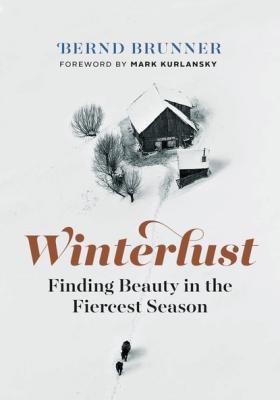Winterlust. Bernd Brunner
Читать онлайн.| Название | Winterlust |
|---|---|
| Автор произведения | Bernd Brunner |
| Жанр | Спорт, фитнес |
| Серия | |
| Издательство | Спорт, фитнес |
| Год выпуска | 0 |
| isbn | 9781771643535 |
Contents
Foreword by Mark Kurlansky
1 / What Makes Winter “Winter”?
4 / Bundling Up and Stripping Down
6 / Letters from Heaven
7 / The Metamorphosis of Snow and Ice
8 / Drifts and Disorientation
9 / The Harshest Winter
10 / Capturing the Essence of Winter
11 / Reimagining Winter
12 / Slip Sliding Away
13 / Flora, Fauna, and Folklore
14 / Too Much Snow?
15 / Winter in the City
16 / Winterfest
17 / The Vanquishing of Winter
18 / Snows of Tomorrow
Selected Bibliography and Sources for Quotes
List of Illustrations
Acknowledgments
Index of People and Places
Falling snowflakes entice us to play, early twentieth century.
Horse-drawn sleighs race across the snow, ca. 1870.
Foreword
IT DOES NOT require an intense study of history, science, and the development of civilization to see that humans have a clear preference for heat over cold. Consider, for example, that people learned to make ice millennia after they first made fire. Moreover, despite the fact that heating has been available for far longer than air conditioning, they have always been more drawn to hot countries than to cold. Perhaps this is because plants grow better in heat? And yet, hot doesn’t always mean food: more fish live in cold seas than in warm ones.
For centuries, the origins of cold were a mystery. Aristotle believed it originated in water. The seventeenth-century scientist Robert Boyle—considered the first chemist in the modern sense of the word—easily disproved this idea by pointing out that many substances that lacked any water could become very cold. Rock and metal come to mind. Still, Aristotle’s erroneous theory seems less improbable than the widely held medieval European belief that cold originated in a place called Thule, an uncharted island in the middle of the Atlantic.
It has often been suggested that the reason humans more readily embrace heat than cold is because heat is associated with life and cold with death. Of the four seasons, spring, the season of birth, is the favorite and summer is much loved. Fall is wistfully reflected upon as a poetic tragedy and harbinger of the death that is to come in those tough few months of winter until, at last, we once more get to spring.
Even I, I admit, shared the common bias toward heat, and it took me many years to grasp the fact that people and cultures in the extreme cold are as rare, exotic, and fascinating as those in the tropics.
This fascination is the core idea in Winterlust. For those with winterlust, the season lays down its challenges—chiefly how to devise strategies to survive it. Bernd Brunner covers these, to be sure, but he also revels in more lighthearted topics such as the structure of snowflakes; the science, history, and technology of the snowman; and the playful glow of a welcoming hearth.
There have always been those consumed by winterlust. The Russians, for example, are famous for their love-hate relationship with snow. Tolstoy’s memorable story “Master and Man” is all about an aristocrat and a serf lost in a blizzard. But Brunner reminds me that there is a more extensive winter literature out there. He quotes from my favorite passage of James Joyce at the end of Dubliners, about snow falling in Ireland, and he demonstrates that while not often remembered for this, the New England Transcendentalists—chiefly Ralph Waldo Emerson and Henry David Thoreau—were great winter enthusiasts.
Their predilection for this season is not surprising since before beach holidays became the fashion, New England was mostly associated with winter. Indeed, the early European explorers of eastern Canada and New England postulated that the winter in those regions was so harsh that the area was unsuited for habitation, which is a curious observation when you consider that the area was inhabited when they arrived. There have always been people who know how to live in extreme winter, but temperate-zone people have tended to ignore them.
The New England literature and art I am familiar with is full of winter, including John Greenleaf Whittier’s morose poem “Snow-Bound,” where a “cheerless” sun rises over “hills of gray.” But, as Brunner points out, winter also inspires, for it can be dazzlingly beautiful. Rockwell Kent, though a New Yorker, was driven to New England, Newfoundland, Greenland, and Alaska by a winterlust that produced stunning moonlit snowscapes, dramatic portraits of ice drifts, and his starkly illustrated account of a voyage to Greenland, N by E.
Reflecting on the work of Kent goes some way to gaining an understanding of the dramatic pull of winter. But better yet, read the insights offered by Brunner in Winterlust’s wide-ranging exploration of the challenges and charms of the cold season.
MARK KURLANSKY, author of Salt: A World History and Cod: A Biography of the Fish that Changed the World
Winter fun on Boston Common, ca. 1856
Author’s Note
IN THIS BOOK, both imperial and metric units are used, which means that temperatures are given in both Fahrenheit and Celsius. These measurements have a story of their own, one that contains a certain irony, because Daniel Fahrenheit, a German by birth who worked in Amsterdam in the early seventeenth century, developed a system that is used in few countries
